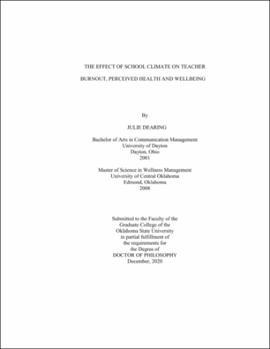| dc.contributor.advisor | Miller, Bridget M. | |
| dc.contributor.author | Dearing, Julie | |
| dc.date.accessioned | 2021-05-25T20:32:25Z | |
| dc.date.available | 2021-05-25T20:32:25Z | |
| dc.date.issued | 2020-12 | |
| dc.identifier.uri | https://hdl.handle.net/11244/329951 | |
| dc.description.abstract | The health and wellbeing of teachers is not only good for teachers, it is also critical for students wellbeing and academic outcomes. Using the Social Ecological Model to drive this study and considering the school climate at the organization level, this study focuses on how the school climate effects teacher's burnout, perceived health and wellbeing. School climate was measured by the strength of the school district's wellness policy as it addressed staff health and practice of staff wellness programming, along with the five dimensions of the staff personnel survey of the Center on Positive Behavioral Interventions & Supports (PBIS) School Climate Survey (staff connections, structure for learning, school safety, physical environment, and peer and adult relations). Teacher burnout was measured utilizing the Copenhagen Burnout Inventory, wellbeing through the World Health Organization Wellbeing Index (WHO-5) and perceived health through a single question. A multivariate regression analysis was used to analyze to identify school climate dimensions that effect teacher burnout, perceived health and wellbeing. Major findings include the peer and adult relations dimensions having the largest effect on teacher burnout as well as effecting perceived health. The staff connections dimension was also found to have a negative relationship with burnout. School safety was found to effect perceived health, as the perception of school safety decreased, the participants perceived health decreased as well. Lastly staff wellness programming in practice was found to have a positive effect on teacher wellbeing. Future recommendations include school districts implementing the Center of Disease Control and Prevention's Whole School, Whole Community, Whole Child (WSCC) Model. Fully implementing the ten components of the WSCC model will work to increase safety in the school setting. Schools should put emphasis on the social and emotional school climate to work toward reducing burnout and increasing perceived health. Lastly, committing to staff wellness through the district school wellness policy and fully implementing staff wellness programming will work towards increasing teacher wellbeing while also increasing the culture of health and wellbeing in the school setting. | |
| dc.format | application/pdf | |
| dc.language | en_US | |
| dc.rights | Copyright is held by the author who has granted the Oklahoma State University Library the non-exclusive right to share this material in its institutional repository. Contact Digital Library Services at lib-dls@okstate.edu or 405-744-9161 for the permission policy on the use, reproduction or distribution of this material. | |
| dc.title | Effect of school climate on teacher burnout, perceived health and wellbeing | |
| dc.contributor.committeeMember | Hubach, Randolph | |
| dc.contributor.committeeMember | Hildebrand, Deana | |
| dc.contributor.committeeMember | Wheeler, Denna | |
| osu.filename | DEARING_okstate_0664D_16985.pdf | |
| osu.accesstype | Open Access | |
| dc.type.genre | Dissertation | |
| dc.type.material | Text | |
| dc.subject.keywords | burnout | |
| dc.subject.keywords | perceived health | |
| dc.subject.keywords | school health | |
| dc.subject.keywords | teacher | |
| dc.subject.keywords | wellbeing | |
| dc.subject.keywords | whole school | |
| dc.subject.keywords | whole community | |
| dc.subject.keywords | whole child | |
| thesis.degree.discipline | Health, Leisure and Human Performance | |
| thesis.degree.grantor | Oklahoma State University | |
